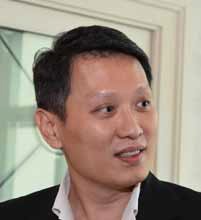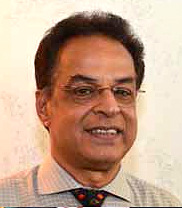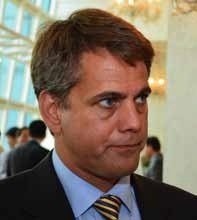 Senior CFA Singapore members and other senior financial industry practitioners and association leaders were at an industry dialogue in March on how to best deter stock market manipulation. The closed door session was moderated by Dr. Tony Tan, CFA (Head of Standards and Financial Market Integrity at CFA Institute, Asia Pacific).
Senior CFA Singapore members and other senior financial industry practitioners and association leaders were at an industry dialogue in March on how to best deter stock market manipulation. The closed door session was moderated by Dr. Tony Tan, CFA (Head of Standards and Financial Market Integrity at CFA Institute, Asia Pacific).Photos by Sim Kih
A RECENT CFA Institute survey identified market fraud as the top concern of Singapore members about the local market. CFA Singapore, with the support of CFA Institute, invited industry experts to discuss how market manipulation happens, what is being done to deter it and possible remedies. At the dialogue were
Their discussion was published in the recent issue of The CFA Singapore Quarterly produced by NextInsight, and is republished here with permission.
Many retail investors were burnt after 3 small-cap stocks crashed in October 2013, wiping out close to S$9 billion in market value in a mere 3 days. Stock prices of Blumont Group, Asiasons Capital and LionGold Corp slumped by more than 80%. As market participants came to view stocks, especially small caps, with heightened suspicion, trading volumes on the Singapore bourse during the first two months of this year tumbled 40% year-on-year.
What can be done to restore investor confidence?
 “Low-priced stocks may be more susceptible to market manipulation - hence the joint consultation with the MAS proposing the imposition of a minimum trading price.” - Richard Teng, Chief Regulatory Officer of SGXAt the closed-door event, SGX Chief Regulatory Officer Richard Teng provided illustrations on the Exchange’s regulatory role and function.
“Low-priced stocks may be more susceptible to market manipulation - hence the joint consultation with the MAS proposing the imposition of a minimum trading price.” - Richard Teng, Chief Regulatory Officer of SGXAt the closed-door event, SGX Chief Regulatory Officer Richard Teng provided illustrations on the Exchange’s regulatory role and function.The Monetary Authority of Singapore is the key regulator of capital markets. Most of the key legal provisions overseeing the capital market, including licensing and oversight of market operators and participants such as member firms and fund managers as well as administering fund-raising and prospectus provisions are prescribed under the Securities & Futures Act and Securities and Futures Regulations.
As a frontline regulator, SGX is a co-regulator that works closely with the MAS to supervise listed companies and member firms as well as to monitor market activities. For instance, companies seeking listings that intend to raise money will have their prospectuses approved by the MAS in addition to having their listing applications approved by SGX. Also, member firms will need to be licensed and supervised by MAS over and above their membership approval by SGX.
SGX is one of the few exchanges in the world that conduct real-time surveillance. It is also one of the few exchanges that query companies on a real-time basis.
1. Queries to listed companies when there are unusual trading patterns that could not explained by market sentiment, industry trends, corporate developments and other factors. This serves to extract yet-to-be disclosed material information as well as to alert investors of the observed unusual market action.
3. Designation of a security where, in SGX’s opinion, there is manipulation of the security, excessive speculation, or if it is in the interest of the market. SGX will deploy the appropriate tool depending on circumstances, unusual trading activities observed and risks involved. SGX uses SMARTS, a market surveillance and compliance technology solutions system from NASDAQ OMX.
Here is an illustration of what the system helped SGX surveillance analysts detect:
On one occasion just before the market closed, the price of a stock that had announced a takeover offer jumped from S$6.25 to S$6.42. This was unusual as the takeover price was S$6.25. A trader had placed a sell order for 200,000 shares before the pre-closing routine and withdrawn the order just before it matched. By doing so, the trader was able to shift the equilibrium stock price to S$6.42. SGX called the trader and found that he keyed in a sell order for 200,000 shares when he had only 55,000 shares. SGX referred the case to MAS for further investigation.
On 22 September 2010, MAS announced that it had imposed a civil penalty of $50,000 on the trader and suspended his Capital Markets Services representative licence for 3 months.
Market abuses and misconduct such as insider trading and market manipulation are offences under the Securities and Futures Act. SGX cooperates with the relevant regulatory agencies such as MAS and CAD for investigation into such misconduct as SGX is not a state agency and does not have state powers to call witnesses and seize records.
 “It will be nice if the SIAS takes the lead in class action in Singapore. Lawyers here are not cheap. At an individual investor level, merely the first step of locating the relevant affected people already amounts to a lot of effort.” - Mano Sabnani, Chairman and CEO Rafflesia HoldingsREVIEW OF TRADING SAFEGUARDS
“It will be nice if the SIAS takes the lead in class action in Singapore. Lawyers here are not cheap. At an individual investor level, merely the first step of locating the relevant affected people already amounts to a lot of effort.” - Mano Sabnani, Chairman and CEO Rafflesia HoldingsREVIEW OF TRADING SAFEGUARDS
Before 26 Sep 11, the non-cancellation phase of the closing routine was fixed at 5:05pm. As part of its regular reviews, SGX implemented initiatives to enhance market transparency:
• Publication of real-time indicative equilibrium prices during the Opening and Closing Routines
• Random ending to the Pre-Open and Pre-Close phases of the Opening and Closing Routines.
In 2012, SGX commissioned a study to examine if the safeguards were effective in enhancing market quality. The findings show that order amendments were made earlier which suggest that the safeguards do have an impact on order behaviour as intended.
More recently, MAS and SGX conducted a review of market structure and practices and concluded that Singapore’s market structure and practices are fundamentally sound. This is in line with the IMF assessment last year that Singapore’s financial services sector is well regulated with a high level of adherence to international standards.
There are a few areas of possible enhancements. MAS and SGX have invited public feedback to these proposals with the aim of further promoting orderly trading and responsible investing by imposing:
• A minimum share price for companies listed on SGX Mainboard
• Collateral requirements for trading
• Short position reporting
The consultation paper for reviewing securities market structure and practices also proposed improving the transparency of trading restrictions imposed by broking houses, strengthening the process for admitting new listings and enforcing action against listing rule breaches.
 “There is sometimes a fine line between where you can clamp down hard and where you don’t in order not to kill the market. A measured approach is important.” - T.K. Yap, CFA Executive Director of OCBC Securities
“There is sometimes a fine line between where you can clamp down hard and where you don’t in order not to kill the market. A measured approach is important.” - T.K. Yap, CFA Executive Director of OCBC Securities
The SGX has an onerous task of watching over the market. My question is whether it is feasible to try to know what is going on in the market place. The market place is made up of individuals who exercise their own ingenuity.
As long as there is an opportunity to make money, and the desire, people will take their chances and walk on the edge. Some of them will even find ways to walk over the edge and hope they don’t get caught. That is often driven by greed. You can’t really anticipate how market participants are crossing the edge. That’s why it’s not surprising to see rules being tweaked after something major happens in any market around the world.
 “We can do a lot of internal training, but deterrence of market fraud is going to boil down to effective detection and effective enforcement of external sanctions by a regulator.” - Adrian Chan, Head of Corporate, Lee & LeeSHOULD DIRECTORS PLAY A BIGGER ROLE WHEN THERE IS UNUSUAL PRICE STOCK MOVEMENT OF THE COMPANY THEY ARE IN?
“We can do a lot of internal training, but deterrence of market fraud is going to boil down to effective detection and effective enforcement of external sanctions by a regulator.” - Adrian Chan, Head of Corporate, Lee & LeeSHOULD DIRECTORS PLAY A BIGGER ROLE WHEN THERE IS UNUSUAL PRICE STOCK MOVEMENT OF THE COMPANY THEY ARE IN?We co-operate with other regulatory agencies in investigations. Market manipulation has been more challenging to investigate compared with insider trading. To investigate market manipulation, we need to first consider which parties may be working in concert, how they work together and how they are connected.
The charts of Blumont, Asiasons and Liongold showed a steady upward gradient over one and a half years even though there were no significant earnings. Their prices did not reflect the ups and downs of the market due to macro factors.
 “Securities class action is very important to institutional investors in the United States.” - Daniel S. Drosman, Founding Partner of Robbins Geller Rudman & Dowd
“Securities class action is very important to institutional investors in the United States.” - Daniel S. Drosman, Founding Partner of Robbins Geller Rudman & Dowd
Class action addresses the situation when investors bought the stock at an inflated price suffered a real loss.

